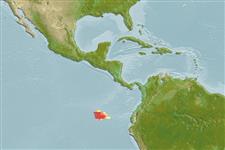Common names from other countries
Environment: milieu / climate zone / depth range / distribution range
Ecología
Batidemersal. Tropical; 90°N - 90°S, 180°W - 85°W
Southeast Pacific: Galapagos Islands.
Length at first maturity / Tamaño / Peso / Age
Maturity: Lm ? range ? - ? cm Max length : 160 cm TL macho / no sexado; (Ref. 1394); 130 cm TL (female); peso máximo publicado: 68.0 kg (Ref. 1394); peso máximo publicado: 68.0 kg
Inhabits rocky shores with boulders and lava, under ledges, and in spaces between boulders, where they seek shelter from the sun. Feeds on a variety of small squid species and several species of schooling fish. Found in rocky shores with boulders and lava, under ledges, and in spaces between boulders, where they seek shelter from the sun. Feeds on a variety of small squid species and several species of schooling fish (Ref. 1394).
Jefferson, T.A., S. Leatherwood and M.A. Webber. 1993. (Ref. 1394)
IUCN Red List Status (Ref. 130435)
CITES status (Ref. 108899)
Not Evaluated
Human uses
Pesquerías: comercial
FAO - pesquerías: species profile | FishSource | Sea Around Us
Herramientas
Más información
Age/Size
Crecimiento
Length-weight
Length-length
Morfología
Larva
Abundancia
Fuentes de Internet
Estimates based on models
Preferred temperature
(Ref.
115969): 5.8 - 23.9, mean 19.2 (based on 22 cells).
Vulnerability
Very high vulnerability (90 of 100).
Price category
Unknown.
